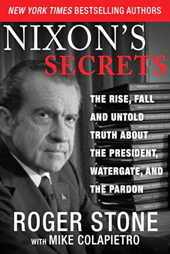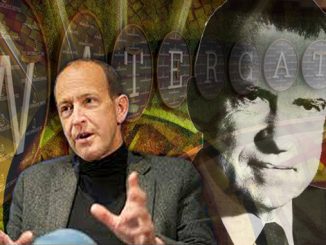
Watergate “hero” Bob Woodward has always relied on dubious investigative tactics…
Publisher Simon & Schuster reported that Bob Woodward’s newest book, Fear: Trump in the White House, sold over 750,000 copies on its first day in print. Woodward skeptics and Watergate revisionists still question Woodward’s monarchical hold on modern journalism and publishing. In this issue, S.T. Patrick begins a series that will spotlight the questionable tactics and little-known fallacies of Bob Woodward’s journalistic career.
Series by S.T. Patrick
Implicit in the “Note to Readers” that opens Bob Woodward’s newest book, Fear: Trump in the White House, is an act of faith. Woodward wants the reader to trust him. “Interviews for this book were conducted under the journalistic ground rule of ‘deep background,’ ” Woodward writes.
Woodward, now an associate editor with The Washington Post, then defines “deep background.” He can use all information gathered from “hundreds of hours of interviews” with “firsthand participants and witnesses” whose names you’ll never know. In case the reader questions his accuracy in repeating these quotations and stories, Woodward then informs the public that “nearly all” of the interview participants have allowed him to record the conversations “so the story could be told with more precision.”
It is not clear how many interviews were actually conducted, nor is the specific percentage of recordings referred to as “nearly all.” This is important, because there is no evidence accompanying those unrecorded interviews. The interviewee would surely deny them, and the accuracy of such reports hinges on the reporter’s own trustworthiness. This is but one of the many problems with “deep background,” a journalistic information magnet strategy Woodward popularized during the Watergate era. Today, every interviewee for Fear is a Deep Throat.

Even when attributing exact quotations, Woodward admits that they may come from the person being quoted, but they may also stem from a colleague with direct knowledge or from someone’s meeting notes. But not all meeting notes are created equal, and because we do not know the source in many of these instances, we cannot question the motivations or backgrounds or prior relationships of the source attributing the quote, thought, or conclusion. Therefore, even the attributions are a cloudy haze of journalistic cloak-and-dagger games that Woodward mastered and legitimized to push his narratives to notable and profitable heights.
Fear is Woodward’s 19th book. His fame came from his Watergate reporting with co-author and fellow Washington Post journalist Carl Bernstein. That’s the story we are supposed to believe: It was the stellar work of a muckraking journalist that made him famous. The little guys hustled to bring down the Big Bad Wolves of Pennsylvania Avenue—the Nixon White House. All the President’s Men was released in 1974 and all the American stereotypes applied two years before the nation’s bicentennial: that hard work eventually triumphs, that good wins over evil, that David really can slay Goliath, and that the new Mr. Smiths going to Washington to speak truth to power are the journalists who work tirelessly to assure that truth reigns.
The problem with that red, white, and blue myth is that it was the stuff of Hollywood—literally. Woodward and Bernstein did not commit to writing All the President’s Men until actor Robert Redford had expressed interest in purchasing the film rights. In Telling the Truth About Lies: The Making of All the President’s Men, Woodward also noted that Redford urged “Woodstein” to change the narrative from a tale of Nixonian dirty deeds to one that was based on the journey of two journalists, Woodward and Bernstein. Redford would play the role of Woodward and Dustin Hoffman would play Bernstein. The film was nominated for Best Picture in 1976 but lost to “Rocky.” For Woodward and Bernstein, however, their careers were made. Redford and Hoffman perfectly portrayed everything Americans wanted their journalists to be, down to being sloppy dressers, coffee inhalers, and chain smokers. Most importantly, they were heroes.
The film adaptation of Woodward and Bernstein’s first book coincided with the release of their second Nixon-era exposé, The Final Days. This book was different only in that its heroes were former and current military men, frustratingly skirting protocol and even law solely in an effort to save the republic from a president who had become unhinged. More than in All the President’s Men, Woodward’s pattern of assessing presidencies would begin in The Final Days.
 The hero of The Final Days was Gen. Alexander Haig, retired from the Army and someone who had climbed the national security ranks to become chief of staff after the resignation of H.R. Haldeman. After Woodward and Bernstein, the hero of All the President’s Men had been Woodward’s “deep background” source, Deep Throat. Though Woodward revealed—or at least informed us—in 2005 that Deep Throat was FBI Associate Director Mark Felt, Watergate revisionists knew more about the real Bob Woodward than the mainstream media was portraying and had good reasons to question the trustworthiness of Felt as the lone, chief or majority source behind the revelations attributed to Deep Throat.
The hero of The Final Days was Gen. Alexander Haig, retired from the Army and someone who had climbed the national security ranks to become chief of staff after the resignation of H.R. Haldeman. After Woodward and Bernstein, the hero of All the President’s Men had been Woodward’s “deep background” source, Deep Throat. Though Woodward revealed—or at least informed us—in 2005 that Deep Throat was FBI Associate Director Mark Felt, Watergate revisionists knew more about the real Bob Woodward than the mainstream media was portraying and had good reasons to question the trustworthiness of Felt as the lone, chief or majority source behind the revelations attributed to Deep Throat.
Woodward had his own secret origin, and it was one that would alter the way keen students of history and the Watergate era viewed his faux heroism, his journalistic methods, the role of Haig, and the character of Deep Throat.
Part I of this series was originally published in American Free Press Issue 39 & 40, Sept. 24 and Oct. 1, 2018.
Bob Woodward: The King Breaker?
As of mid-October 2018, Bob Woodward’s newest book, Fear: Trump in the White House, stands atop The New York Times Best Seller list for hardcover non-fiction. Woodward skeptics and Watergate revisionists still question Woodward’s monarchical hold on modern journalism and publishing. In this issue, corresponding editor S.T. Patrick continues with Part 2 in a series that will spotlight the questionable tactics and little-known fallacies of Bob Woodward’s journalistic career.
On March 6, 1989, would-be authors Len Colodny and Robert Gettlin sat with The Washington Post’s Bob Woodward in preparation for what would be their upcoming book Silent Coup: The Removal of a President (1991). Woodward and co-author Carl Bernstein had written what establishment historians and educators considered the two books of record on the end of Richard Nixon’s presidency: All the President’s Men (1974) and The Final Days (1976). Both would be made into films. On this day, however, Colodny and Gettlin had confirmed information that would turn the Watergate story—and Woodward’s role in it—on its head.
Woodward verified that he had worked at the Pentagon as a communications officer. This was already in contrast with the book and film notion of Woodward as a bottom-rung hoofer who was fighting his way up the journalistic ladder at the Post. The film created the legend that all Woodward had done was to write about the lack of cleanliness in local restaurants. When the editors debated the oncoming storm of Watergate reporting, it was in an effort to decide if Woodward was even qualified to write such a consequential story. In reality, he was, and the editors knew it.
Woodward denied to Gettlin that he had any other function at the Pentagon beyond having once been a communications watch officer. Gettlin then asked if Woodward had ever done “any briefings of people.”
“Never! . . . And I defy you to produce somebody who says I did a briefing. It’s just . . . It’s not true,” Woodward responded.

The conversation turned to Gen. Alexander Haig, who had become Nixon’s chief of staff upon the urged resignation of H.R. Haldeman. Tim Weiner, upon Haig’s death in 2010, wrote in The New York Times that Haig had been the “acting president” while Nixon was pre-occupied with Watergate. Haig biographer Roger Morris wrote that President Gerald Ford’s pardon of Nixon was a de facto pardon of Haig, as well.
Haig had played an important role in the transition from Nixon to Ford and had even been one of the most instrumental voices privately encouraging Nixon’s resignation. If Haig had a previous working relationship with Woodward, and if Woodward’s stories were contradictory to the Nixon administration’s best interests, then the relationship and roles of both Woodward and Haig in relation to Nixon’s fall demanded examination.
“I never met or talked to Haig until some time in the spring of 1973,” Woodward responded. That Woodward had never done briefings, had never been a briefing officer, and had never met Haig until 1973 were ideas that sources “in a position to know,” as Gettlin called them in the interview, contradicted.
Lest someone assume that Colodny and Gettlin’s sources on Woodward were journalistic rivals or disenfranchised victims made unemployable by Watergate’s political aftermath, they were not. And unlike Woodward’s most notable sources, they were not kept hidden under “deep background.” Colodny and Gettlin’s confirmation came from Adm. Thomas H. Moorer, Melvin Laird, and Jerry Friedheim, all of whom can be read and heard on “Watergate.com.”
Moorer, the chairman of the Joint Chiefs of Staff (1970-1974), told Gettlin that he was aware that Haig was being briefed by Woodward. Moorer was in close contact, sometimes “on the telephone with Haig eight or nine times a day.”
Laird, Nixon’s secretary of defense, said, “I was aware that Haig was being briefed by Woodward. . . . He was there on a temporary assignment.” This was while Woodward was working in communications at the Pentagon.
Friedheim, a Pentagon spokesperson, elaborated on Woodward’s Pentagon associations in the pre-Watergate era. “He was definitely there, and he was moving in circles with—you know—as a junior officer, as a briefer, but obviously it’s somebody that they thought was sharp enough to do those things,” Friedheim said. “He was moving with those guys, Moorer, Haig, the NSC [National Security Council] staff, and other military types.”
 Colodny and Gettlin were not the first, nor were they the last, to tie Haig to the role of Woodward’s most famous Watergate source, “Deep Throat.” In his 1984 book Secret Agenda: Watergate, Deep Throat, and the CIA, Jim Hougan wrote that Haig was the “ ‘prominent official’ within the Nixon administration who most closely fits Woodward’s description of his source.” There are Watergate historians who still believe that Deep Throat was a composite of sources, with Haig being chief among them, or someone other than the FBI’s second in command, Mark Felt.
Colodny and Gettlin were not the first, nor were they the last, to tie Haig to the role of Woodward’s most famous Watergate source, “Deep Throat.” In his 1984 book Secret Agenda: Watergate, Deep Throat, and the CIA, Jim Hougan wrote that Haig was the “ ‘prominent official’ within the Nixon administration who most closely fits Woodward’s description of his source.” There are Watergate historians who still believe that Deep Throat was a composite of sources, with Haig being chief among them, or someone other than the FBI’s second in command, Mark Felt.
The release of Secret Agenda was a new starting point for Watergate skeptics in 1984; Silent Coup reorganized them once again in 1991. Author Ray Locker will continue to question Woodward’s links to the Nixon White House in 2019’s Haig’s Coup.
Woodward, exasperated by the questioning of Colodny and Gettlin further in the 1989 interview, referenced the briefing revelation and the Haig tie as a “totally erroneous story . . . that I briefed somebody in the Pentagon . . . and that there’s this coup going on.” He had yet to learn that no less than Moorer, Laird, and Friedman had all openly established a Woodward link to Haig.
He would also repeatedly ask about the nature of the interviewer’s sources, about whom Colodny and Gettlin then vaguely referred. It seems that Woodward was perturbed to be the target of yet-unnamed sources who verified information and scenes in which he was involved. He had popularized the practice and allowed its subjects to deal with the consequences. But Hougan, Colodny, Gettlin, and Locker have since put that translucent lens back on Woodward.
Part II of this series was originally published in American Free Press Issue 41 & 42, Oct. 8 and 15, 2018.
Bob Woodward’s Tarnished Legacy – Part III
S.T. Patrick continues his series on Woodward and his monarchical hold on modern journalism by profiling The Washington Post associate editor’s work throughout the 1980s. This is the third installment in the series.
Though the Republican Party seemed all but dead after Watergate, the pardon of Richard Nixon, and the 1976 electoral loss of unelected President Gerald Ford to Gov. Jimmy Carter, the Eighties were a new decade, one that would attach the word “era” to the politician that dominated its most crucial moments, Ronald Reagan.
For journalist Bob Woodward, the fall of the GOP had made him a legend. The rise of the Reagan era, however, would prove that legends are highly fallible, even in the world of journalism, where kings are rarely dethroned.
In September 1980, reporter Janet Cooke wrote an incredibly moving and emotional piece for the Post entitled “Jimmy’s World.” Cooke detailed the heartbreaking story of an eight-year-old heroin addict. So captivating was the story that Woodward, then the Post’s assistant managing editor, nominated it for a Pulitzer Prize. In April 1981, it won. Cooke would later have to return the Pulitzer when it was revealed that the story had been a fabrication. Rather than making an apology, Woodward defended the merits of the story and removed himself from any responsibility for the nomination.

In 1984, taking a brief respite from political tomes, Woodward released Wired: The Short Life & Fast Times of John Belushi. Both Woodward and Belushi had been raised in Wheaton, Ill. Riding the wave of notoriety he had amassed after Robert Redford’s portrayal of him in “All the President’s Men,” Woodward convinced Belushi’s friend Dan Aykroyd, brother James Belushi, widow Judith Belushi Pisano, actress Blair Brown, and others to sit for interviews in preparation. For those who had known and worked alongside him, the memories of Belushi, who had died of a drug overdose in 1982, were fresh.
When Wired was released, Belushi’s friends, family, and co-stars felt betrayed. Because Belushi had disliked Nixon and had liked Woodward’s work, his widow had turned to the Post editor and bestselling author when she had questions about the LAPD’s handling of the death. What Woodward did was to take the story and create a very critical, drug-fueled, exaggerated narrative of Belushi’s stardom.
Veil: The Secret Wars of the CIA, 1981-1987 marked Woodward’s return to home base, the world of D.C. politics. Having roundly suffered what he believed was unfair criticism for Wired, Woodward may have thought his political wheelhouse would harbor a safe return to the accolades and fame of a decade before.
Veil includes one of the most hotly debated scenes ever written by Woodward. In it, former CIA director William Casey lies near-death in a hospital bed at Georgetown University Hospital.
Woodward makes his way into the room and asks Casey if he had known about the illegal diversion of profits from Iranian arms sales to the Nicaraguan Contras. Casey’s head “jerked up hard. He stared and finally nodded yes,” Woodward wrote.
“Why?” Woodward puzzlingly asked. Casey paused and whispered, “I believed.”
Kevin Shipp, a former member of Casey’s own security detail, wrote that none of the agents standing guard would have allowed Woodward into the room. He also noted that the former CIA director was not able to speak at the time of Woodward’s Q&A. Casey’s daughter, Bernadette Casey Smith, told the Houston Chronicle that Woodward “never got the deathbed confession.”
While the Casey story seems clearly like fantasy, The New Yorker’s John Cassidy, in describing both Veil and other Woodward work, discussed his faults in a more muted, yet specific way. “The real rap on Woodward isn’t that he makes things up,” Cassidy wrote. “It’s that he takes what powerful people tell him at face value; that his accounts are shaped by who cooperates with him and who doesn’t; and that they lack context, critical awareness, and, ultimately, historic meaning.”
The Nineties would bring a return to Watergate and, for Woodward, a kinder, gentler Democratic administration. But in the new millennium, 9/11, multiple wars, and the George W. Bush administration would be just the combatant-like foes that Woodward would need to rebuild a legacy he had self-tarnished in the 1980s and failed to recover in the 1990s.
Part III was published in American Free Press Issue 43 & 44, October 22 and 29, 2018.
S.T. Patrick holds degrees in both journalism and social studies education. He spent 10 years as an educator and now hosts the “Midnight Writer News Show.” His email is [email protected].



